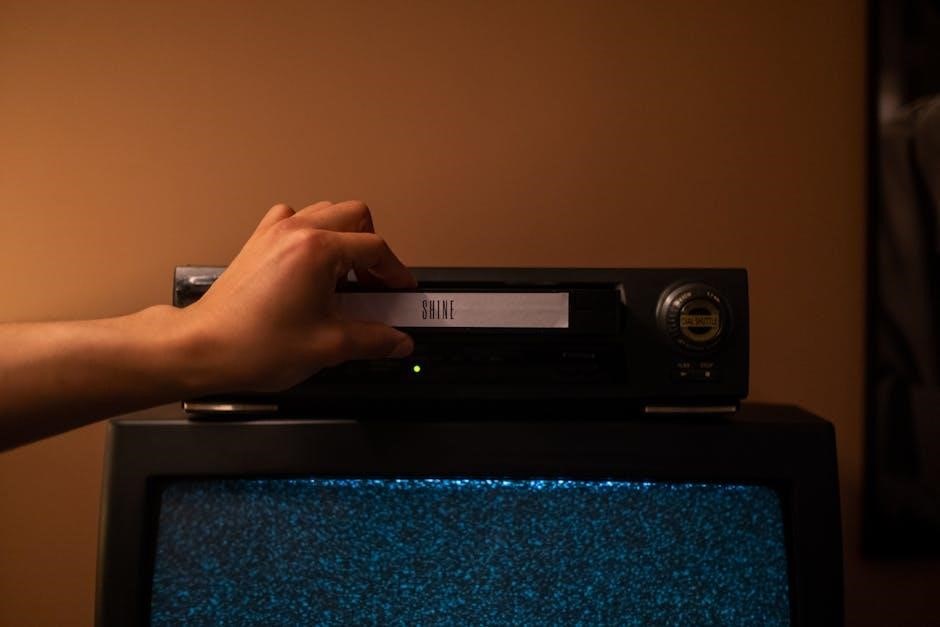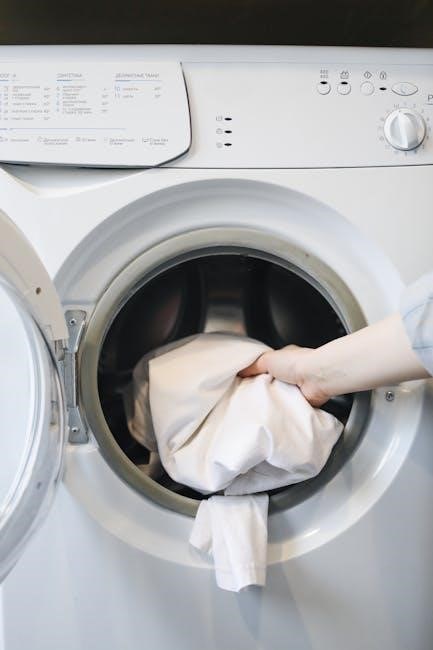The Honeywell W7220 manual provides essential guidance for installing, configuring, and operating the JADE Economizer Module, designed for HVAC systems. It ensures proper setup and functionality, catering to technicians and operators.
1.1 Overview of the Honeywell W7220 Controller
The Honeywell W7220 is a JADE Economizer Module designed for HVAC systems, offering advanced control for energy-efficient ventilation. It operates as a stand-alone unit or integrates with commercial thermostats and sensors, providing dry-bulb economizer control. Compatible with Honeywell actuators like the MS7403, it supports Sylk Bus connections for optional sensors. Its compact design and user-friendly interface simplify installation and operation, making it a versatile solution for optimizing indoor air quality and reducing energy consumption in commercial spaces.
1.2 Importance of the Manual for Installation and Operation
The manual is crucial for proper installation, configuration, and operation of the Honeywell W7220. It provides detailed instructions, wiring diagrams, and troubleshooting guides, ensuring seamless setup and optimal performance. Without it, incorrect installation could lead to system malfunctions or safety risks. The manual also covers maintenance and advanced features, helping users maximize energy efficiency and system longevity. Referencing it ensures compliance with industry standards and Honeywell’s best practices, making it an indispensable resource for technicians and operators.

Product Specifications and Features
The Honeywell W7220 is a JADE Economizer Module featuring Sylkbus two-wire communication, compatible with MS7403 actuators, and designed for HVAC systems to enable efficient dry-bulb economizer control.
2.1 Key Features of the Honeywell W7220 Economizer Module
The Honeywell W7220 Economizer Module offers advanced features including Sylkbus two-wire communication, direct connections for sensors and actuators, and compatibility with Honeywell MS7403 actuators. It supports stand-alone operation with optional sensors and integrates seamlessly with commercial thermostats. The module is designed for energy-efficient dry-bulb economizer control in HVAC systems, providing precise temperature management and reducing operational costs. Its robust design ensures reliable performance and easy configuration, making it a versatile solution for various industrial applications.
2.2 Technical Specifications of the W7220 Controller
The W7220 controller operates on 24VAC and features Sylkbus two-wire communication for seamless connectivity with sensors and actuators. It includes 2-pin and 6-pin connectors (Honeywell part numbers 50048926-001 and 50048926-002). The module supports optional sensors for enhanced functionality and is compatible with Honeywell MS3103J and MS3105J actuators. Designed for industrial applications, it ensures precise control and energy efficiency in HVAC systems. Its technical specifications align with industry standards, providing reliable performance and durability for various economizer configurations.

Installation Instructions
The W7220 installation requires pre-installation checks, wiring according to diagrams, and proper mounting. Connect sensors and actuators, ensuring 24VAC power supply. Follow safety guidelines strictly.
3.1 Pre-Installation Requirements
Before installing the Honeywell W7220, ensure compatibility with HVAC systems and verify power requirements. Gather necessary tools and components, including 24VAC power supply. Review the manual thoroughly to understand safety precautions and installation steps. Ensure all sensors and actuators are compatible and properly rated. Prepare the mounting location, ensuring accessibility and compliance with local electrical codes. Familiarize yourself with the wiring diagrams provided in the manual to avoid connection errors. Proper preparation ensures a smooth and safe installation process.
3.2 Step-by-Step Installation Guide
Mount the W7220 controller in an accessible location, ensuring proper ventilation. Connect the 24VAC power supply to the controller, following the wiring diagram. Attach sensors and actuators using the provided 2-pin and 6-pin connectors. Secure all connections tightly to avoid signal loss. Connect the controller to the thermostat and optional Sylk Bus sensors. Power up the system and run the diagnostic test to ensure functionality. Refer to the manual for specific wiring configurations and troubleshooting tips to ensure a successful installation.
3.3 Wiring Diagrams and Connections
Refer to the wiring diagrams in the manual for precise connections. Use 2-pin (Honeywell part #50048926-001) and 6-pin (part #50048926-002) connectors for sensors and actuators. Connect the 24VAC power supply to the controller, ensuring all wires are securely attached. Link optional Sylk Bus sensors for enhanced functionality. Follow the diagram to connect the controller to thermostats and actuators like the MS7403. Verify connections match the economizer configuration to ensure proper operation. Always consult the manual for specific wiring layouts and compliance with standards like ASHRAE guidelines.
3.4 Power-Up and Initial Setup
After wiring, apply 24VAC power to the controller. The display will show “Honeywell” on the first line and “Economizer W7220” on the second. Perform a manual or automatic DCV calibration (DCVCAL ENA) as needed. Ensure all sensors and actuators are properly connected. Verify the system operates correctly by checking the display for any error messages. Familiarize yourself with the default settings before making adjustments. This initial setup ensures the economizer is ready for configuration and operation, providing a smooth start for system integration.

Configuration and Programming
Configure the W7220 by setting up sensors, actuators, and operating parameters. Program the controller for optimal performance, ensuring proper integration with HVAC systems and components. Use manual or automatic calibration options to fine-tune settings, enabling precise control over economizer functions. Adjustments can be made via the interface, ensuring the system operates efficiently under various conditions. Proper configuration ensures energy-saving performance and reliable operation. Refer to the manual for detailed programming steps and customization options. This section guides users through advanced setup procedures for tailored functionality.
4.1 Configuring the W7220 Economizer Module
Configure the W7220 Economizer Module by setting up sensors, actuators, and operating parameters. Use the stand-alone dry-bulb configuration or integrate it with Sylk Bus sensors. Connect to optional sensors for single or differential control. Ensure proper wiring to thermostats and actuators like the MS7403. Follow manual guidelines for calibration and parameter settings. Configure input/output connections and enable communication protocols. Define setpoints and operating modes. Refer to the manual for detailed configuration steps and troubleshooting tips to ensure optimal performance. Proper setup ensures energy efficiency and reliable system operation.
4.2 Programming the Controller for Optimal Performance
Program the W7220 controller by enabling DCV and configuring operating modes. Setpoint calibration and actuator configuration are crucial for precise control. Use the manual to guide input/output settings and communication protocols. Optimize energy efficiency by enabling economizer functions and adjusting parameters. Refer to the manual for detailed programming steps and troubleshooting. Proper programming ensures the module operates efficiently and integrates seamlessly with HVAC systems. Always follow the manual’s instructions for accurate configuration and performance. This ensures reliable operation and maximizes system effectiveness.
4.3 Setting Up Sensors and Actuators
Connect sensors like CO2 or temperature sensors to the W7220 for precise environmental monitoring. Use Honeywell actuators such as MS7403 for direct control of HVAC systems. Ensure proper wiring, referencing the manual for diagrams. Configure actuators to match system requirements, ensuring accurate responses. Calibrate sensors for accurate data transmission. Proper setup ensures seamless integration and optimal system performance. Follow manual guidelines for Sylk Bus connections and differential control configurations to maximize efficiency and reliability.
4.4 Advanced Configuration Options
The Honeywell W7220 allows for advanced customization through Sylk Bus integration and custom control logic. Enable remote monitoring and adjust parameters like sensor thresholds and actuator response times. Access these features via the controller’s interface or connected software tools. Configure differential control for precise temperature management. Customizable alarms and notifications enhance system oversight. Refer to the manual for detailed steps to unlock and tailor these settings for enhanced performance and efficiency. Proper setup ensures optimal system adaptability and reliability.

Operation and Control
The Honeywell W7220 module operates seamlessly, controlling temperature, humidity, and CO2 levels. It supports Auto and Manual modes, ensuring efficient system management and energy optimization.
5.1 Understanding the Operating Modes
The Honeywell W7220 operates in two primary modes: Auto and Manual. In Auto mode, it automatically adjusts settings based on sensor inputs for optimal energy efficiency. Manual mode allows direct control over outputs, enabling precise adjustments. Additionally, the module supports DCV (Demand Control Ventilation) calibration, enhancing system performance. Remote monitoring options provide real-time insights, ensuring seamless control and adaptability to changing conditions. Understanding these modes is crucial for maximizing the module’s functionality and efficiency in various HVAC applications.
5.2 Using the Controller’s Interface
The Honeywell W7220 controller features an intuitive interface with an LCD display, allowing users to navigate through menus and settings effortlessly. The interface provides real-time data, including current operating mode, sensor readings, and active alarms. Users can adjust settings, view system status, and access configuration options using the dedicated navigation buttons. The interface is designed to be user-friendly, ensuring easy operation and monitoring of the economizer module. This streamlined design enhances user experience and simplifies system control.
5.3 Monitoring and Controlling the System
The Honeywell W7220 allows for precise monitoring and control of HVAC operations through its advanced interface. Users can track temperature, humidity, and CO2 levels in real-time, ensuring optimal environmental conditions. The controller supports adjustable setpoints and automated responses to system demand. Additionally, it provides alerts for system anomalies, enabling proactive maintenance. With its robust monitoring features, the W7220 ensures efficient energy management and maintains consistent indoor air quality, making it a reliable choice for commercial applications.
5.4 Remote Access and Monitoring Options
The Honeywell W7220 supports remote monitoring and control through integration with Honeywell’s SylkBus network, enabling real-time system oversight via compatible software or mobile apps. This feature allows users to access temperature, humidity, and CO2 levels remotely, ensuring optimal system performance. Remote monitoring also enables timely troubleshooting and adjustments, reducing downtime. By connecting to Honeywell’s building management systems, the W7220 offers seamless integration for comprehensive facility management, enhancing energy efficiency and operational insights.
Maintenance and Troubleshooting
Regular maintenance ensures optimal performance. Clean sensors, check wiring, and update software. Troubleshooting guides help diagnose issues like faulty actuators or communication errors, ensuring swift resolution.
6;1 Routine Maintenance Procedures
Regular maintenance is crucial for optimal performance. Inspect and clean sensors, actuators, and connections to ensure proper operation. Verify wiring integrity and check for loose connections. Perform software updates as needed to maintain functionality. Clean the controller’s exterior and internal components to prevent dust buildup. Ensure all sensors are calibrated and functioning correctly. Check actuators for proper operation and replace if necessary. Review system logs for any error messages and address them promptly. Schedule routine maintenance every 6 months or as recommended by Honeywell.
6.2 Common Issues and Solutions
Common issues with the Honeywell W7220 include sensor calibration errors, wiring faults, and software glitches. For sensor issues, recalibrate or replace sensors as needed. Check wiring connections for loose points and ensure proper insulation. If the controller fails to power up, verify the power supply and connections. For software-related problems, perform a factory reset or update the firmware. Refer to the manual for detailed troubleshooting steps and solutions. Regular maintenance can prevent many of these issues, ensuring reliable system performance and efficiency.
6.3 Troubleshooting Guide
The Honeywell W7220 troubleshooting guide helps identify and resolve operational issues. Start by checking the power supply and ensuring all connections are secure. Review the wiring diagram to verify proper connections. If the controller displays error codes, consult the manual for specific solutions. Test sensors for accuracy and ensure they are configured correctly. For communication issues, verify Sylk Bus connections and settings. Resetting the controller or updating firmware may resolve software-related problems. Always refer to the manual for detailed diagnostic procedures and solutions tailored to the W7220 module.
6.4 Diagnostic Tools and Techniques
The Honeywell W7220 module offers advanced diagnostic tools to identify system issues. Use the controller’s interface to monitor error codes and system status. Check wiring diagrams for proper connections and verify sensor accuracy. Utilize optional sensors for detailed system monitoring. Test communication settings for Sylk Bus connections. Ensure power supply is stable and within specifications. Review firmware updates for improved functionality. Refer to the manual for step-by-step diagnostic procedures to resolve issues efficiently and maintain optimal performance of the economizer module.

Technical Documentation and Resources
The Honeywell W7220 manual and supporting documents are available online, including installation guides, product data, and technical references, ensuring comprehensive access to necessary information.
7.1 Types of Manuals Available for the W7220
The Honeywell W7220 offers various manuals, including the Installation Instructions, Technical Reference Manual, Product Data, and Operators Manual. These resources provide detailed guidance for setup, configuration, and operation, ensuring users can effectively utilize the economizer module. Additional documents cover troubleshooting and advanced features, catering to both technicians and operators. All manuals are available for free online viewing or downloading in PDF format, making it easy to access the information needed for optimal performance and maintenance.
7.2 Downloading the PDF Manual
The Honeywell W7220 manuals are readily available for download in PDF format, ensuring easy access to essential information. Users can find the Installation Instructions, Technical Reference Manual, and Operators Manual online. These documents can be downloaded from Honeywell’s official website or trusted directories like ManualsDir.com. The PDF manuals are free to access, allowing users to view or print them as needed. This convenient option ensures that technicians and operators have all the necessary resources at their fingertips for proper installation, configuration, and operation of the W7220 Economizer Module.
7.3 Online Resources and Support
Honeywell offers extensive online resources and support for the W7220 module, ensuring comprehensive assistance. Users can access product data, installation guides, and troubleshooting tips through Honeywell’s official website and partner platforms. Additionally, online forums and technical support teams provide solutions for common issues. These resources enable users to resolve queries efficiently, ensuring optimal performance of the W7220 Economizer Module in various HVAC applications.

Compliance and Certifications
The Honeywell W7220 module adheres to industry standards, ensuring compliance and certifications for safe and efficient operation in HVAC systems, meeting regulatory requirements globally.
8.1 Industry Standards and Compliance
The Honeywell W7220 Economizer Module complies with industry standards, ensuring reliable performance and safety. It meets ASHRAE 90.1 energy efficiency requirements and is UL-certified, guaranteeing adherence to safety protocols. Additionally, it aligns with environmental regulations, including RoHS and Energy Star standards, promoting sustainable operation. Compliance with these standards ensures the module integrates seamlessly with building management systems while meeting local and international codes, providing users with a trusted and efficient solution for HVAC applications.
8.2 Certifications for the Honeywell W7220
The Honeywell W7220 Economizer Module holds multiple certifications, ensuring compliance with industry standards. It is UL-certified, meeting rigorous safety requirements for electrical devices. Additionally, the module complies with ASHRAE standards for energy efficiency and environmental regulations such as RoHS. These certifications validate its reliability, safety, and environmental sustainability, making it a trusted choice for commercial HVAC applications. The W7220 also adheres to Energy Star guidelines, further enhancing its eco-friendly credentials and operational efficiency in various industrial settings.
Accessories and Replacement Parts
The Honeywell W7220 supports various accessories, including MS3103J and MS3105J actuators, and compatible sensors for enhanced functionality. Replacement parts, like 2-pin and 6-pin connectors (50048926-001/002), are available.
9.1 Compatible Sensors and Actuators
The Honeywell W7220 is compatible with a range of sensors and actuators, including MS3103J and MS3105J communicating actuators. These components ensure precise control and integration with the economizer module. Optional sensors can be connected via Sylk Bus for single or differential measurement, enhancing system flexibility. The module supports stand-alone configurations, directly wiring to thermostats and sensors for dry-bulb economizer control. Proper pairing of sensors and actuators optimizes performance and energy efficiency in HVAC applications.
9.2 Replacement Parts and Accessories
The Honeywell W7220 supports various replacement parts and accessories, including 2-pin and 6-pin connectors (part numbers 50048926-001 and 50048926-002), available in 20-unit accessory bags. These components are essential for maintaining system functionality. Additionally, the HH63AW002 Jade controller is included in the hardware kit for seamless integration. Replacement parts ensure optimal performance and are readily available through Honeywell’s support channels, making maintenance straightforward and efficient. Proper use of these accessories guarantees the W7220 operates at its full potential.
Frequently Asked Questions (FAQs)
Common questions about the Honeywell W7220 include troubleshooting, installation steps, and compatibility with other systems. Users often inquire about sensor configurations and optimal performance settings.
10.1 Common Questions About the W7220
Common questions about the Honeywell W7220 often revolve around its installation steps, wiring diagrams, and troubleshooting procedures. Users frequently inquire about resolving error codes and ensuring proper sensor compatibility. Additionally, there are questions regarding communication issues with other devices and optimizing the module’s performance. Understanding how to integrate the W7220 with existing systems is also a prevalent query among operators and technicians.
10.2 Answers to Technical Queries
Technical queries about the Honeywell W7220 are addressed by providing detailed guidance on configuration steps, wiring diagrams, and troubleshooting procedures. The manual clarifies how to connect sensors and actuators for optimal performance. It also explains how to resolve common issues like communication errors and sensor malfunctions. Additionally, the guide offers solutions for remote monitoring setup and compatibility issues with other systems. Troubleshooting sections help users identify and fix problems efficiently using diagnostic tools and error code references.

Advanced Features and Applications
The Honeywell W7220 offers advanced features like energy-efficient control, integration with Honeywell systems, and customizable configurations, enabling enhanced performance and remote monitoring for smart HVAC solutions.
11.1 Energy Efficiency and Savings
The Honeywell W7220 optimizes energy efficiency by intelligently managing HVAC operations. Its advanced economizer module reduces energy consumption by utilizing outdoor air for cooling when conditions permit. This feature minimizes mechanical cooling, lowering energy costs and environmental impact. The module’s precise temperature control ensures optimal performance without unnecessary energy expenditure, making it an eco-friendly solution for commercial environments. By integrating with smart sensors, it maximizes savings while maintaining comfort levels, ensuring a balance between efficiency and functionality.
11.2 Integration with Other Honeywell Systems
The Honeywell W7220 seamlessly integrates with other Honeywell systems, enhancing overall HVAC management. It connects to Honeywell thermostats, sensors, and actuators via Sylkbus communication, ensuring synchronized operation. This integration allows for centralized control and monitoring, optimizing system performance. Compatibility with Honeywell’s MS3103J and MS3105J actuators further streamlines functionality, enabling advanced automation and energy-saving strategies. The W7220’s ability to work within Honeywell’s ecosystem makes it a versatile solution for integrated building management, ensuring efficient and coordinated system operation.
The Honeywell W7220 manual provides comprehensive guidance for installing, configuring, and operating the JADE Economizer Module. It ensures optimal performance and energy efficiency in HVAC systems, offering detailed troubleshooting and maintenance tips. By following the manual, users can maximize the module’s potential, integrate it with other Honeywell systems, and achieve advanced control over environmental conditions. This resource is essential for technicians and operators seeking to leverage the W7220’s capabilities effectively.
12.1 Summary of the Honeywell W7220 Manual
The Honeywell W7220 manual is a comprehensive guide for the JADE Economizer Module, detailing installation, configuration, and operation. It covers key features, technical specifications, and troubleshooting. The manual also includes wiring diagrams, sensor setups, and advanced configuration options. Designed for HVAC systems, it emphasizes energy efficiency and integration with Honeywell systems. Available in PDF, the manual provides essential information for technicians and operators, ensuring optimal performance and compliance with industry standards. It serves as a vital resource for maximizing the module’s capabilities and maintaining system efficiency.
12.2 Final Thoughts on Installation and Usage
The Honeywell W7220 manual provides clear, detailed instructions, ensuring successful installation and operation. By following the guidelines, users can optimize the module’s performance, leveraging its energy-saving features. Proper setup and configuration are crucial for achieving desired results. The module’s compatibility with Honeywell systems enhances functionality, making it a reliable choice for HVAC applications. Adhering to the manual’s recommendations ensures efficient and trouble-free operation, maximizing the module’s potential for energy efficiency and system control.